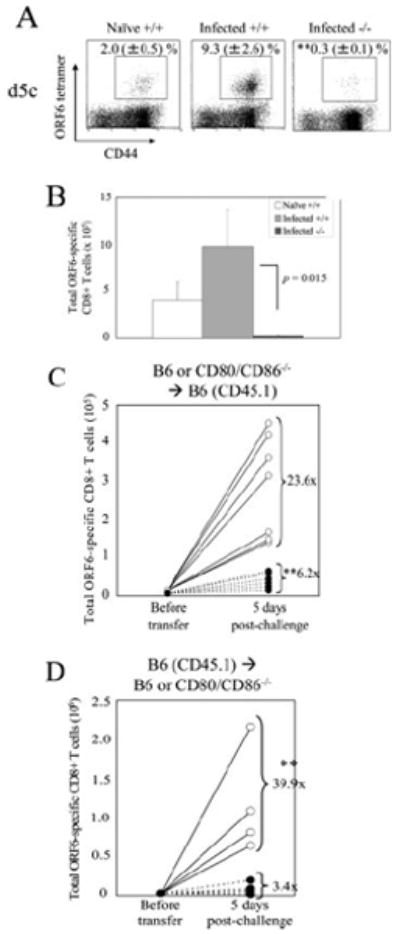FIGURE 6.

Costimulatory requirements for recall responses of memory CD8+ T cells during a low-level persistent infection. Naive C57BL/6, MHV-68-infected C57BL/6, or CD28−/− mice were challenged with 2 × 106 PFU of VV-ORF6 i.p. and were analyzed for ORF6-specific CD8+ T cell expansion in the spleens by tetramer staining 5 days postchallenge. Representative plots gated on CD8+ cells (A) and total number of ORF6-specific CD8+ T cells (B) are shown. Numbers indicate percentage of ORF6–tetramer+CD8+ T cells (±SD). Representative data from two independent experiments consisting of three or four mice per group are shown. C and D, CD28 costimulation is required both during the priming and recall phase for maximal recall responses of MHV-68-specific CD8+ T cells. C, In brief, 2 × 106 purified CD8+ T cells from spleens of MHV-68-infected B6 or CD80/CD86−/− mice (number of ORF6-specific memory CD8+ T cells determined by tetramer staining) were transferred into naive B6-CD45.1+ mice. One day posttransfer, mice were challenged with 2 × 106 PFU of VV-ORF6 i.p. and expansion of B8R-specific CD8+ T cells in the spleen were enumerated by tetramer staining 5 days later. D, In brief, 8 × 106 purified CD8+ T cells from spleens of MHV-68-infected B6-CD45.1+ mice (number of ORF6-specific memory CD8+ T cells determined by tetramer staining) were transferred into naive B6 or CD80/CD86−/− mice. One day posttransfer, mice were challenged with 2 × 106 PFU of VV-ORF6 i.p. and expansion of ORF6-specific CD8+ T cells in the spleen were enumerated by tetramer staining 5 days later. Representative data from two individual experiments are shown. ○, B6→B6; ●, CD80/CD86−/−→B6 (C) or B6→CD80/CD86−/− (D). Each set of connected circles represent individual mice, and numbers indicate average fold expansion of transferred memory cells after 5 days in each group, calculated as written in Materials and Methods. *, p < 0.05; **, p < 0.01.
